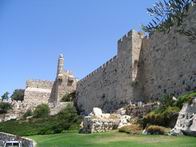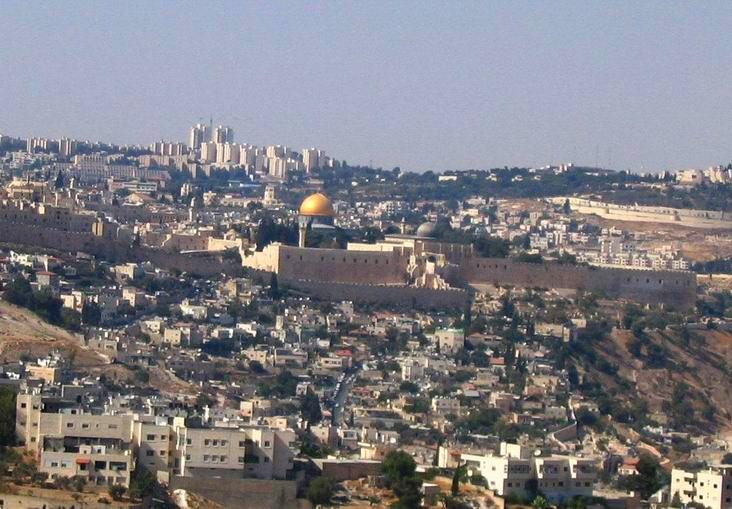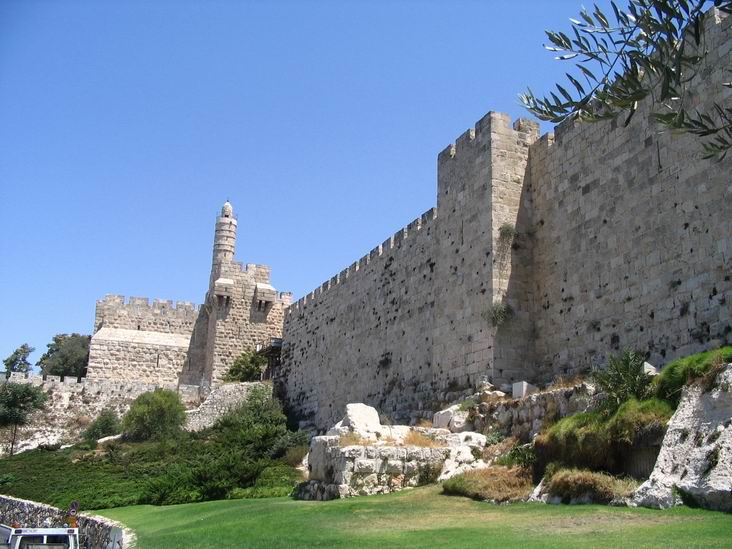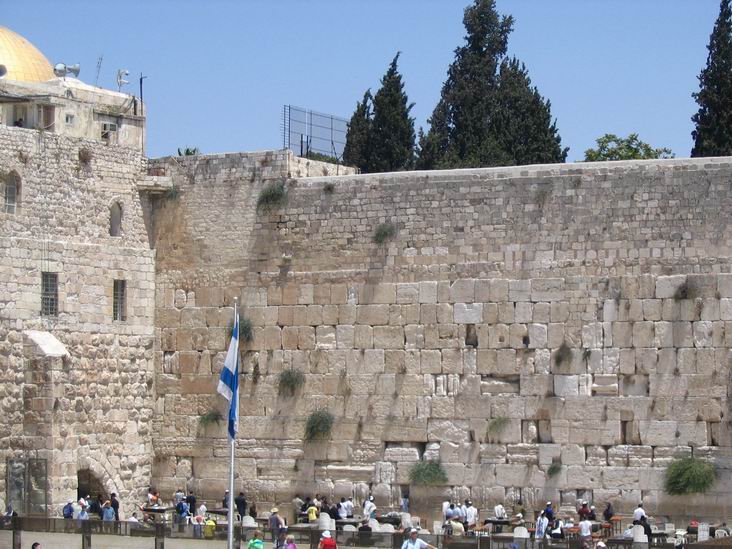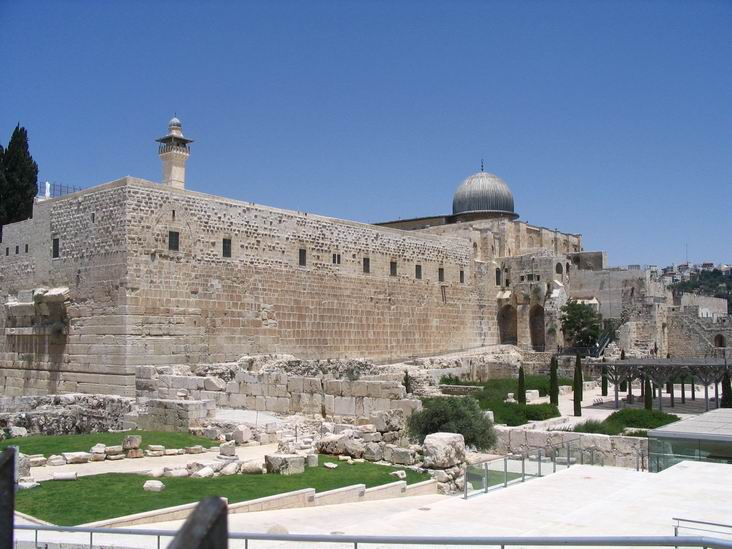The Holy City of Jerusalem is for 3000 years the capital of the Israelites, Jewish Kingdom and State of Israel. This page is an overview of the old city of Jerusalem. Details of its sites are described in additional web pages.
Psalms 122:2: “Our feet shall stand within thy gates, O Jerusalem”.
Home > Sites > Jerusalem (Overview)
Contents:
Overview
History
Photos
Sites Gallery
List of sites
Map
Aerial view
Visit
Biblical
Etymology
Links
Overview:
Jerusalem, the capital of Israel and the most Holiest city in the World, is located in the center of Israel, on top of the Judean mountains (700-800M above sea level). This strategic location, first selected by King David 3000 years ago, made the city the heart of the biblical Israel and the Jewish faith, a Holy city for the Christian and Muslim faiths, and the capital of Modern Israel.
History of Jerusalem:
Jerusalem’s long history is summarized in several highlights along the timeline:
- ~18 century BC – Referenced in Egypt as “Rushalimum”
- Mid Bronze II – Referred in the bible as Cananaite “Shalem” (Genesis 14: 18)
- ~14TH century BC – Mentioned as “Urasalim” in the Amarna letters, a 14th century BC Egyptian archive of clay tablets
- ~1250 BC – Adonei Zadek, King of Shalem, is defeated by Israelite’s Joshua (Joshua 10)
- 1000 BC – King David conquers the city from the Jebusites; establishes his capital
- 950 BC – King Solomon builds the 1st Temple
- 701 BC – King Hezekiah refortifies the city and repels the Assyrians
- 586 BC – 1st Temple is ruined by Nebuchadnezzer; Israel is exiled
- 536 BC – Exiles return to Jerusalem, reconstruct the ruined city and walls
- 516 BC – 2nd Temple is built
- 332 BC – Alexander the Great conquers the city; starts Hellenism influence
- 165 BC – Hasmonaim Liberate city from Antiochus IV; Jerusalem is Israel’s capital again
- 63 BC – Pompey takes the city; Roman rules starts (until 614AD)
- 37-4 BC – Herod takes the city; massive rebuilding of city and the temple
- 4 BC – 66 AD – Roman procurators rule the city (with Herod’s descendant kings)
- ~33 AD – Jesus is trialed and crucified by Pontius Pilate (5th Roman procurator of Judea)
- 66-70 AD – Jewish rebels take the city
- 70 AD – Jerusalem and its temple ruined by Titus
- 132 AD – Jewish Rebels retake the city
- 136 AD – City is razed; Hadrian establishes Aelia Capitolina
- 335 AD – Constantine and his Mother Helena convert the city to Christianity
- – Church of the Holy Sepulcher is erected
- 614 AD – Persians take the city for a brief time
- 638 AD – Arabs conquer the city; later build the Dome of the Rock mosque (691) and Al-Aksa mosque (705)
- 1099 AD – Crusaders take the city; hold it until 1187
- 1187 AD – Saladin recaptures the city
- 1267 AD – Mamelukes take the city; hold it until 1517AD
- 1517 AD – Turks take the city; later (1538) Suleiman “the Magnificent” builds the current walls
- 1832 AD – General Ibrahim Pasha, General of Egypt, conquers the city (until 1841)
- 1867 AD – Charles warren starts the archaeological digs
- 1917 AD – British rule until 1948
- 1948-1949 AD – Israel’s Independence war; Jordan occupies old city; Jerusalem made Israel’s capital
- 1967 AD – East Jerusalem is reunited with West Jerusalem after 6 day war
Selected photos:
The following photo shows the old city, behind walls, from the south. In the center, dominating the old city, is the Golden cape of the Dome of the Rock Mosque. In the background – part of the Modern Jerusalem.
Click on the photo to view it in higher resolution…
A closer look into the old city: David’s Tower, near Jaffa Gate on the west side of the old city, is yet another symbol of the city.
The Temple mount, where the Golden Dome of the Rock Mosque is located, has an inner wall, covering about 1/6 of the old city area. This inner wall also includes the “Wailing Wall” (or, Western Wall), the holiest place for Jews as seen below.
![]() Read more on the Temple mount….
Read more on the Temple mount….
The southern side, adjacent to the western wall, is seen in the following photo. On the left side, embedded in the wall, is the remains of “Robinson’s arch” which was built by Herod as a staircase and gateway into the temple. On the right – the new archaeological garden which features another entrance to the temple mount – a huge staircase. Above, in the temple mount, the Silver dome of the Al-Aqsa mosque (built in 705AD).
![]() Read more on the Southern Wall…
Read more on the Southern Wall…
Jerusalem sites gallery:
Jerusalem is rich of amazing sites, and we cover many of its Biblical sites.
Check our sites gallery of the Jerusalem area. The page summarizes the sites currently reviewed in Jerusalem.
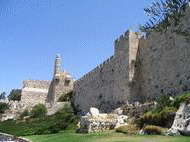
Map / Navigation to featured sites:
Check the Jerusalem maps page where the sites are superimposed on a satellite imagery.
Detailed Jerusalem sites:
The following Jerusalem sites are detailed in other BibleWalks pages:
Tower of David and Jaffa Gate, Zion Gate, Mount Zion, Western Wall, Southern Wall, Temple Mount, Cardo Maximus, Mount of Olives, Basilica of Agony, Yad Avshalom, Tomb of Zechariah, Tombs of Bnei-Hezir, St. Peter in Gallicantu, Mary’s tomb, Ophel and Hulda Gates, Via Dolorosa, Church of Holy Sepulchre, Burnt House, Broad Wall, Augusta Victoria, Monastery of the Cross, St. Francis, Dormition, King David’s tomb, Last Supper , Armenian Church – St. Saviour – Mount Zion, St. James, St. John the Baptist , Sebils , St. Anna, Bethesda, Dominus Flevit, Ascension chapel, Russian Ascension convent, Pater Noster, Golden Gate, New Gate, Lions’ Gate, Flagellation, Condemnation, Roman roads, King David’s harp, Mar Elias monastery, Sultan’s pool, St. Andrews, Ein Karem, Muristan, Redeemer, Al-Aqsa, Dome of the Rock, Dung gate, Second Temple Gates, Jerusalem’s Roman Streets, Western Wall tunnels, Kh. Tililiya, Nebi Samuel, Gihon, City of David, Shiloah Pool, Drainage canal, Givati Car Park, Tancred fortress, Light show 2010, Light show 2014, Ramat Rachel, Sanhedria.
… more to come.
Aerial View:
The following photo covers the entire area of the old city. The temple mount is seen on the lower-right side.

Visit at the sites:
(a) Getting there
Jerusalem is about 1 hour drive east of Tel-Aviv along highway #1, and the walled old city is in the eastern side of the Modern City.
(b) Tower of David, Jaffa Gate
You can drive to the municipal parking lot just outside the walls and near the Tower of David, the medieval fortress on the west side of the old city. There you can enter the walled city through the Jaffa Gate. You can first visit the museum in the tower, where a permanent exhibition of the history of the city is displayed.
(c) Church of the Holy Sepulcher, Via Dolorosa
Walking through Jaffa Gate, into the old city and along David street. Follow the signs to the Christian Quarter to the Church of the Holy Sepulcher. After a visit in the church, walk along Via Dolorosa towards the Temple Mount.
(d) Jewish Quarter, Wailing Wall
From Via Dolorosa you can turn towards the Western side of the temple mount, to the renewed Jewish Quarter.
Alternatively, you can walk from Jaffa Gate around the walls, towards Zion Gate, the Jewish Quarter, or the Wailing Wall. Another option is to take a walk on top of the walls, entering from the outer side of the Tower.
The Western Wall tunnels are also a must to see, but need to be booked in advance.
(e) City of David
The exciting new sites in town, located on the southeast side of the old city. Check the overview page and start your travel back in time to the first and second temple periods.
(f) Mount of Olives
There are many sites in the Mount of Olives area. You can get there from Mount Scopus.
(g) Mount Zion
Check our overview of sites on the south west side of the old city. Park near the Zion Gate, then visit the sites of Mount Zion.
(h) Temple mount
Explore the Temple mount, where everything about Jerusalem started. Access is near the Southern Wall archaeological park, another site to visit.
(i) Panorama view from Armon Hanaziv Prominade
The best view of the city (from a distance) can be seen from the south side, along the Armon Hanaziv Promenade. The recommended time to visit this beautiful terrace overlooking the city is the afternoons.
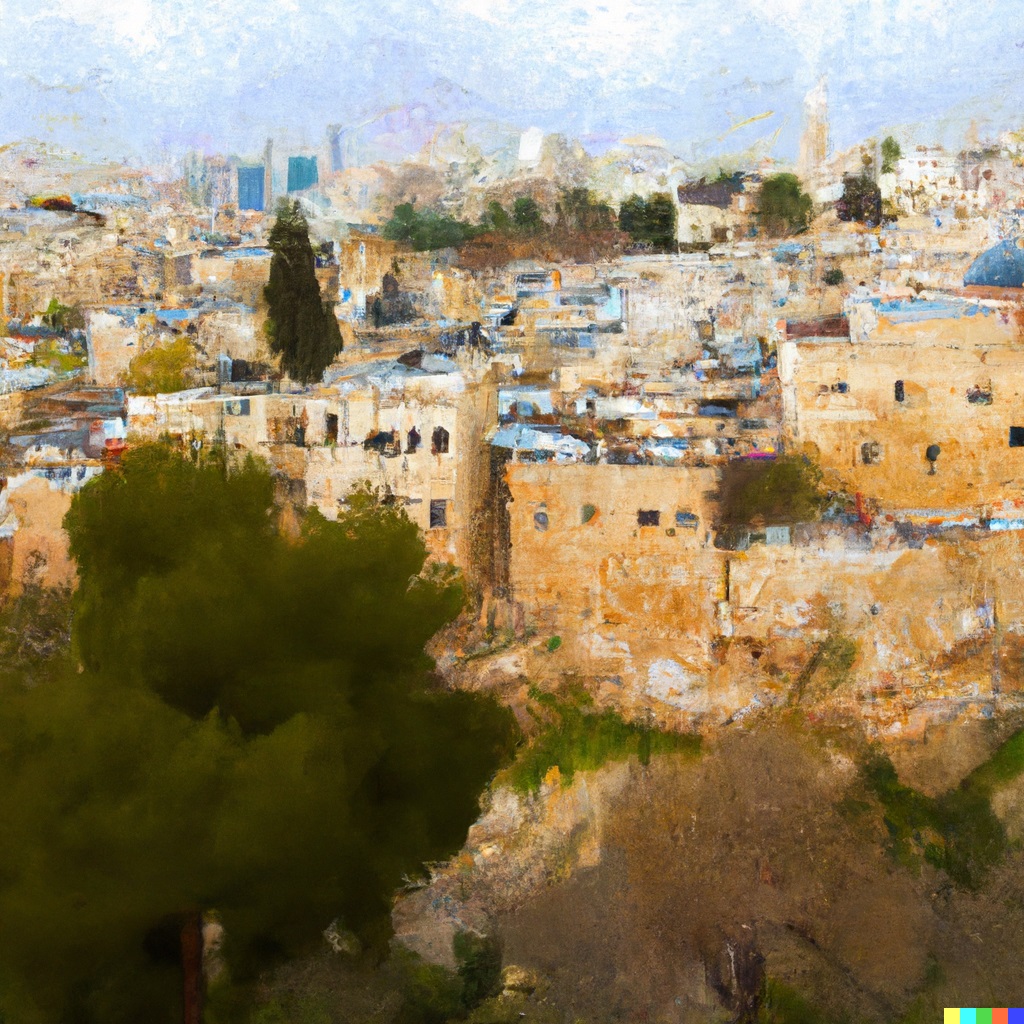
Jerusalem, oil painting style – Computer generated illustration by DALL-E 2
Biblical References:
(a) Genesis 14: 18-19
The first biblical reference of Jerusalem: King of Salem (Shalem, the city before it Jerusalem) blesses Abram:
“But Melchisedech, the king of Salem, bringing forth bread and wine, for he was the priest of the most high God, Blessed him, and said: Blessed be Abram by the most high God, who created heaven and earth.”
(b) Samuel II, 5: 5-11
This text tells about the conquest of Jerusalem from the Jebusites, and builds his palace and capital:
“In Hebron he reigned over Judah seven years and six months; and in Jerusalem he reigned thirty and three years over all Israel and Judah. And the king and his men went to Jerusalem against the Jebusites, the inhabitants of the land, who spoke unto David, saying: ‘Except thou take away the blind and the lame, thou shalt not come in hither’; thinking: ‘David cannot come in hither.’ Nevertheless David took the stronghold of Zion; the same is the city of David.
And David said on that day: ‘Whosoever smiteth the Jebusites, and getteth up to the gutter, and taketh away the lame and the blind, that are hated of David’s soul–.’ Wherefore they say: ‘There are the blind and the lame; he cannot come into the house.’ And David dwelt in the stronghold, and called it the city of David. And David built round about from Millo and inward. And David waxed greater and greater; for HaShem, the G-d of hosts, was with him.
And Hiram king of Tyre sent messengers to David, and cedar-trees, and carpenters, and masons; and they built David a house.”
Etymology (behind the name):
- Rushalimum – Canaanite city; referenced in 18 C BC Egyptian letters
- Shalem – Canaanite city; referred in the Bible; name of a local god, Shalem.
- Yerushalem – Hebrew name; referred in the bible 653 times (4 times as Yerushalaim).
There are several explanations for this word, one of them explaining that the name came from appending the root name “founded” and the city’s name ” Shalem”, which means founded-by-Shalem.
- Colonia Aelia Capitolina – Named by Hadrian in 136AD; Aelia – after his family’s name; Capitolina – after Jupiter’s second name (Capitolinus)
- El-Kuds – “the Holy City” in Arabic,
- Hierusalem – named in Latin Vulgate bible (translated from Greek and Hebrew by St Jerome (Hieronymus) at 382 AD
- Jerusalem – English, German and French name. Note that “Je” replaces “Ye” in most of the biblical names.
- Yerushalaim – In Hebrew, the name of the modern city.
Note that the city has over 70 additional names, such as “David’s city”, “Zion”, “God’s City”.
Links:
* External:
- Jerusalem Archaeological sites – survey of sites, very useful (in Hebrew)
- Jerusalem Insider’s guide – Discover Jerusalem the Most Unique City on Earth
- iTravelJerusalem.com – Jerusalem Hotels, Events, Attractions, Tours, Photos, Videos, Tour Guides
- All about Jerusalem Ron Peled’s site (see also the video collection in our site)
- Jerusalem.com – Jerusalem 3D Virtual Tours, and more
- Christian Information Center in Jaffa Gate, Jerusalem
- Jerusalem 101 – an introduction to the city of Jerusalem
* Internal:
BibleWalks.com – walk with us through the sites of the Holy Land
Sites Navigation: On all featured sites, you can use the navigation aid at the end of the page for proceeding to the next site. The navigation bar takes you through a virtual tour of the sites. At the bottom of each site you can navigate forward or backward, or return back to a full list of all sites in all regions of Israel.
![]() Follow the sites: next Jerusalem site—>>> Tower of David
Follow the sites: next Jerusalem site—>>> Tower of David
This page was last updated on Apr 5, 2023 (add illustration)
Sponsored links:
